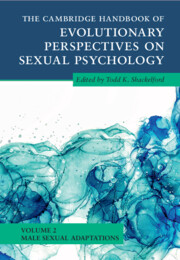Book contents
- The Cambridge Handbook of Evolutionary Perspectives on Sexual Psychology
- The Cambridge Handbook of Evolutionary Perspectives on Sexual Psychology
- Copyright page
- Contents
- Contributors
- Preface
- Part I Precopulatory Adaptations
- Part II Copulatory Adaptations
- Part III Postcopulatory Adaptations
- 14 Postejaculatory Adaptations to Self-Semen Displacement
- 15 Male Mate Retention
- 16 Shifts in Partner Attractiveness
- 17 Emotional Commitment in Men
- 18 Sexual Jealousy in Males
- 19 Men’s Attachment-Related Needs in the Sexual Arena
- 20 Paternal Care
- 21 Paternal Filicide
- Index
- References
17 - Emotional Commitment in Men
from Part III - Postcopulatory Adaptations
Published online by Cambridge University Press: 30 June 2022
- The Cambridge Handbook of Evolutionary Perspectives on Sexual Psychology
- The Cambridge Handbook of Evolutionary Perspectives on Sexual Psychology
- Copyright page
- Contents
- Contributors
- Preface
- Part I Precopulatory Adaptations
- Part II Copulatory Adaptations
- Part III Postcopulatory Adaptations
- 14 Postejaculatory Adaptations to Self-Semen Displacement
- 15 Male Mate Retention
- 16 Shifts in Partner Attractiveness
- 17 Emotional Commitment in Men
- 18 Sexual Jealousy in Males
- 19 Men’s Attachment-Related Needs in the Sexual Arena
- 20 Paternal Care
- 21 Paternal Filicide
- Index
- References
Summary
The formation and maintenance of stable pair-bonds is an important strategy in the human mating repertoire. Ancestral men may have benefited from forming pair-bonds under certain circumstances by increasing offspring success, facilitating paternity certainty, and securing the future sexual access, reproductive resources, and parental investment of their partner. Yet the expected benefits to be gained through maintaining a pair-bond or pursuing alternative strategies, such as emphasizing a short-term mating strategy, switching mates, or pursuing other activities, can be difficult to assess and are ever-changing. The emotion of commitment is argued to act as a superordinate psychological program, coordinating lower-level adaptations to direct attention, process information, and produce behavioral output. Existing social psychological theories of relationship commitment, including attachment theory, interdependence theory, and the investment model, provide a framework for organizing the relevant information in the environment, the reproductive costs and benefits of competing options, and the behavioral strategies appropriate to pursuing different outcomes. In this chapter, I review the features of these models and the empirical evidence each has produced, and attempt to frame each of them in terms of an evolved psychological program for pursuing various reproductive strategies based on environmental cues.
- Type
- Chapter
- Information
- Publisher: Cambridge University PressPrint publication year: 2022



